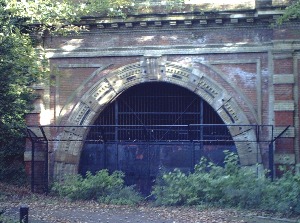
A Crystal Palace Park Walk
Additional Information
|
|
| london-footprints.co.uk |
THE CRYSTAL
PALACE
The Great Exhibition, in a building designed by Joseph Paxton,
opened in May 1851 in Hyde Park. The Crystal Palace, as it became
known, was a great success and by the time it closed in October
over 6 million people had visited. However calls for it to be
retained were rejected and in May 1852 it was sold by Fox &
Henderson to the Crystal Palace Company. Leo Schulster, a
director, sold the company a 300 acre estate in Sydenham where it
was rebuilt in August 1852 – June 1854. The metal frames
were transported by horse wagon and the glass was broken up and
sent to Smethwick to be re-made. The palace was increased in size
and set within a park providing additional attractions for
education and entertainment (a Victorian theme park!). It was the
most visited attraction in London (2 million per year) until 1884
but never made a profit. After the 1880s it became run down and
the company was facing bankruptcy. In 1911 it was purchased by
Lord Plymouth and staged the Festival of Empire. Lord Plymouth
was re-imbursed in 1913 and the park was closed for naval use
during WWI. It re-opened in 1920 without the water features and
attendances were recovering in the 1930s. But in November 1936,
despite the attendance of 88 fire appliances and over 400
firemen, it was destroyed in a spectacular fire.
RAILWAYS
Leo Schulster and Samuel Laing of the Crystal Palace Company were
also director/chairman of the London Brighton & South Coast
Railway which provided a rail service from Sydenham to the
‘low level’ station (present Crystal Palace) which
opened with the palace (linked by a glass covered walkway). The
line was extended from Wandsworth (Dec 1856) and Victoria (Oct
1860) emerging from a 746 yard tunnel from Gipsy Hill. Further
lines were opened southwards to Norwood Junction (Oct 1857) and
Bromley Junction (May 1858). The station was rebuilt in 1875 to
include refreshment rooms but the platform roof was removed in
1906 following the collapse of a similar one at Charing Cross. It
was damaged in WWII then lost its portico in 1963 and north tower
roof in 1976. The new booking hall opened in 1986. Repairs
undertaken in 2000 included the replacement of the north tower
roof, station re-roofing and the construction of a columned
porch.
 |
The London & Croydon Railway, which opened in 1839 mainly along the route of the Croydon Canal, had closed its little-used station at Penge (West) in 1841 but re-opened it in July 1863. On the same day the London Chatham & Dover Railway opened its station, at nearby Penge East, on a line begun in 1861. The LC&D also constructed a line from Victoria via Nunhead to the ‘high level’ station on Crystal Palace Parade which opened in August 1865. This had a grand station building by EM Barry with a tiled subway to the palace. This line did not operate 1917-9 or 1944-6. It finally closed in September 1954 with a steam special. The track was lifted in 1956 and the station demolished in 1961. Houses were built on the site in 1982 but the 45’ diameter turntable area can still be seen from the bridge. |
The siting of the Crystal Palace and the provision of railways led to the development of Anerley, Penge and Sydenham. The railway companies merged as Southern Railways in 1923
THE PARK INFORMATION CENTRE has a display area and can provide information including park maps and a prehistoric monster trail. Tel 020 8778 9496. The MUSEUM is open Saturdays, Sundays & Bank Holidays 11-4:30 (summer) 11-3:30 (winter) or by arrangement. Donations appreciated. Tel 020 8676 0700. [website]
THE CRYSTAL
PALACE FOUNDATION [website] promotes research and education on the
Crystal Palace and produces a number of publications.
A Gallery of historic PHOTOGRAPHS is available on the English
Heritage (Viewfinder) website - search 'Crystal Palace'
The park is on
the GREEN CHAIN waymarked walk [website] and also the CAPITAL RING [website]
A 5 mile green walk along the old Crystal Palace (High Level)
railway was produced by the Friends of the Great North Wood.
[route & what to see] [walkslist]
london-footprints.co.uk 2010